by Glen Springer | Apr 6, 2012
Sales and Marketing Outsourcing Alignment is More than Marketing Automation
As a company that specializes in sales and marketing outsourcing, Gabriel Sales is now a staunch advocate of pulling together an integrated sales and marketing technology stack to align sales and marketing around the one goal of helping your buyer to buy the way your buyer wants to buy. However the technology stack is only about 20% of the challenge we all now face. Getting that technology stack to do what it was designed to do may require significant shifts in both sales process and overall company culture (often from the top of the organization). This blog and the following blogs addresses those challenges at a very high level to arm you with some facts and figures to convince you to take a look at marketing automation and to help you understand that simply implementing a sales and marketing technology stack is no magic bullet.
First here is what a sales and marketing technology stack looks like:
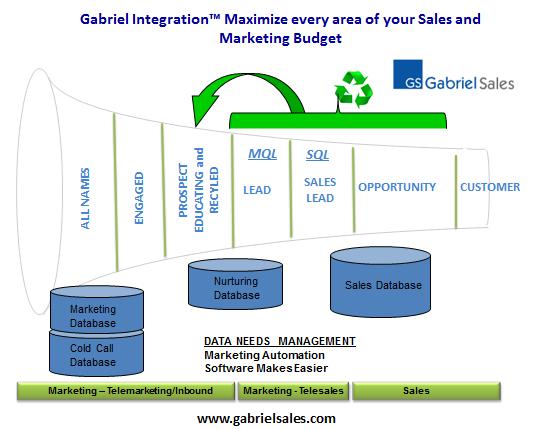
Marketing Automation Software can tie together your inbound and outbound efforts data sets with your sales force database.
Second here are the challenges a sales and marketing stack will present for your business according to Gleanster:
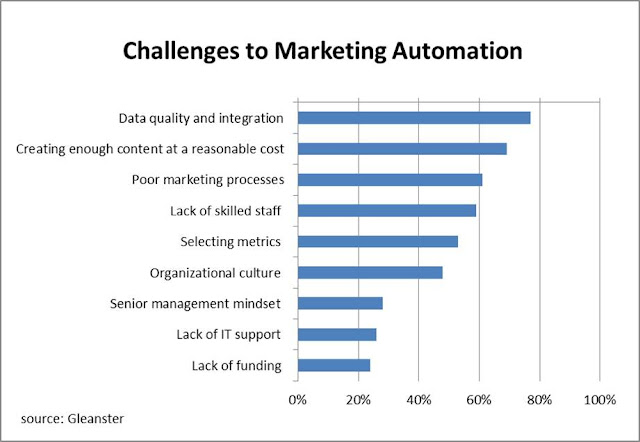
As company known for its sales and marketing outsourcing prowess, we understand that implementing a sales and marketing technology stack requires that you align sales and marketing around the new rules of sales engagement that have the following five pillars:
- Sales Content and Marketing Content designed for helping your buyers where they are in their decision making process.
- Sales reps that are trained in the new rules of sales engagement and closing (hard closing no longer works) that is process driven.
- Giving Sales and Marketing a Shared Sales Quota that rewards putting sales qualified leads in the pipe that close that is metric driven
- Implementing the right technology stack for your sales and marketing organization to leverage as a team.
Success requires that you examine your sales and marketing outsourcing process. Technology doesn’t work unless your team has the incentive, desire, motivation and skill set to make it work.
If any of these struggles or challenges hits a register that resonates for you and your organization it may make sense to consider working with a business that is highly proficient in sales and marketing outsourcing. For more specific tactics you can implement right now we invite you to explore the discrete tactics in our Sell Smarter, Sell Faster White Paper of visit our B2B Demand Generation Knowledge Center. If you would like to receive a benchmark feel free to contact us directly to schedule a quick discovery session.
In the next blog in this series we will comment on some additional research that discusses some of the cultural challenges you may face as reported by Marketing Sherpa and finally we will look at what this means in terms of closing business so you can evaluate if you may be blowing your budget by not implementing the right sales and marketing process.
Related Content:
B2B Demand Generation Engine How To Video
by gabriel_sales | Mar 6, 2012
As an outsourced B2B demand generation company we understand that shifting your culture is not easy. Your sales team and your marketing team may not communicate fluidly. Your outsourced B2B demand generation effort may be focused on B2B lead generation and not closed deals. This blog give you a simple B2B demand generation scorecard as a first step to give Sales and Marketing a shared quota.
As the first step to integrate and align sales and marketing we recommend that you create an agreement between sales and marketing that clearly defines the different stages of a lead and what makes a lead ready to be worked by sales. As an outsourced B2B demand generation team we understand that to two organizations and even personalities within an organization will always agree what a sales qualified lead is so we recommend that this be done in writing. As a second step we recommend that you craft a very simple scorecard so the team works together towards a single goal – Closed business. Once this is done the entire team will be focused on working as a “team” to move deals through your sales process. Keeping the scorecard simple is essential. As a B2B demand generation process consulting firm this is the best practice to frame that scorecard.

Touches to Interest – How many times do you need to attempt to reach them before they show interest.
Interest to Marketing Qualified Lead (MQL) – Interest in your information.
MQL to Sales Accepted Lead – Does it make sense for a Sales Representative to work the deal
Sales Qualified Lead to Proposal – Once a lead is an SQL you need to set benchmarks for how many buyers move to accepting a Proposal or Price Quote
Proposal to Closed Deal – There is no grey area to sales or marketing what the shared quota is all about.
For help, B2B demand generation process consulting or facilitation of conversation between your sales and marketing teams or get some free B2B Demand Generation bench marks feel free to CONTACT US.
For more information on how a top outsourced B2B Demand Generation company approaches increasing velocity in the new economy we invite you to visit more of our blogs:
Top B2B Demand Generation Requires Sales Content Marketing
Top B to B Demand Generation Requires Sales and Marketing Alignment
5 Steps to Launch or Turn Around a B to B Demand Gen Team
by Glen Springer | Feb 3, 2012
 We are calling this a Top 10 demand generation strategies list, but as we went through the strategies, we felt the need to give your b to b demand gen amplifier one more notch and took it to 11. This blog post is a quick reference for your company to build a successful b to b demand generation strategies focused on improving your ROI statement.
We are calling this a Top 10 demand generation strategies list, but as we went through the strategies, we felt the need to give your b to b demand gen amplifier one more notch and took it to 11. This blog post is a quick reference for your company to build a successful b to b demand generation strategies focused on improving your ROI statement.
1. Don’t wait to follow up on leads. You spend $15K, $30K, $100K plus on a trade show. You spend money on inbound pay-per-click, or publishers etc. If the marketing department is in charge of sharing the leads they may score and then share with an internal team or an outside vendor. If the sales team is in charge they will often prioritize by gut. We understand the value of both approaches. You want to call the best prospects first. However, generally what occurs is that lag time of a few hours can turn into days and weeks. That lag time hurts especially if your leads are in a highly competitive industry (getting there first improves your closing % by as much a 100%), your sales cycle is 90 days or less (first 3 get short listed), or your leads are driven by search engine marketing (could be a “just in time” need). Many marketers we talk to will proudly say “we call on incoming leads within a week.” Guaranteed they have never done a study on the effects of that delay.
2. Make those extra calls. Don’t give up on leads after 1 or 2 calls if you don’t connect. This is especially challenging for sales reps that are not supported by a demand gen inside rep. A sales reps’ job is to close business. If they have deals moving this quarter they don’t always have the time to make that third or fourth call. As a b to b demand generation outsourced company and a sales outsourcing solution provider we have done countless studies that have shown that the 3rd, 4th and sometimes 5th attempt is where the payoff comes. This is especially true the more senior the decision maker. They are just tougher to reach.
3. Have an additional piece of content. Have a new offer after every call to keep the prospect engaged and give your rep “a reason to follow up” to ask them what they thought. Bottom line is that content keeps a deal moving without needing to get your senior talent on the phone to educate the prospect. It provides a reason for dialogue. It allows you to keep asking “what else are you curious about or what can I share to help you”. It allows you to talk about their needs while you share your position as well. Selling is about the customer not you and this allows you to kill two birds with one stone.
4. Lead with more than just a demo as your initial offer. As a sales outsourcing company we understand that clients want us to transact now but it doesn’t always work that way. Their strategy is often to get the prospect in that demo as quickly as possible and if the prospect is ready to do that great! However smart b to b demand generation requires that you also have an offer for prospects that aren’t ready to make that commitment. The prospect is not unintelligent. They know that getting into that demo starts them on the path towards committing to buy. They may not be ready to make that decision yet and they don’t want to waste your time or theirs, so give them a way to engage that is a bit softer and slower.
5. Educate but keep the costs down. We live in competitive times so many businesses’ marketing efforts focus on the product and ignore the value of educating their prospects so that they realize the value they are offered. To win deals and ensure you are receiving a top dollar for your product or service the customer needs to understand the value you are driving for their business. To explain that value the customer needs and wants understand that value. So you need to help your customer by helping your customers get what they want – which is fair, independent and “neutral” views that help them take informed and unbiased decisions. This is quick content to create especially for your senior sales executives if you can get them blogging. What is common sense for you as the expert, especially when it comes to competition and the “internal independent research” available, is often very valuable new information for you customer.
6. Don’t forget about your existing customers. They are the core of your business, without them you don’t exist. So the core of your business is that successful relationship. Keep building on that relationship and continue to share content with them to build even more trust. This will organically turn them into advocates. They tweet, they belong to Linked-In, Google . Don’t ask for them to do it. Just make it easy for them. Referrals work in new and unexpected ways so simply be surprised and especially grateful when they ask to contribute content for you.
7. Listen to your sales team and your prospects to generate your content strategy. In many cases, the sales team understands what the customer needs before the customer does. This is especially true if you have a disruptive solution moving into an existing market or an existing solution moving into new markets. Creating a great deal of content quickly is not tough. If you listen to your prospects objections and the same questions or concerns come up several times turn it into a blog post. You can than take that sales conversation to address other prospects’ needs and, even more importantly to your b to b demand generation effort, take that “sales conversation” into the social media conversation.
8. Know your the inflection point for your ROI statement when implementing a Marketing Automation Platform and Nurturing program. A platform (as an outsourced sales company we recommend Pardot) cost $16K. A 3 series webinar will cost you roughly $6K-$10K in house or external. Basic blog content creation will cost about $12K. And planning, database integration and implementation can range from$12K to $24K. So all in you are looking at $72K if you are starting from scratch. If you are following the best practices laid out above or you have implemented a sales outsourcing solution, or b to b demand generation solution with Gabriel Sales, you will already have a great deal of the content planning you need so an implementation is roughly $24K-$36K. You can do the math from there (we have a back of the envelope chart below to help). If your average deal size is $100K the ability to track digital content and the time savings alone for the senior rep makes it an easy decision to pull the trigger. For smaller and shorter sales cycles it really comes down to how many leads you have in your database because countless studies have shown that if your product has legs you can expect to convert at least 1% to 3% of the leads that were initially just curious:
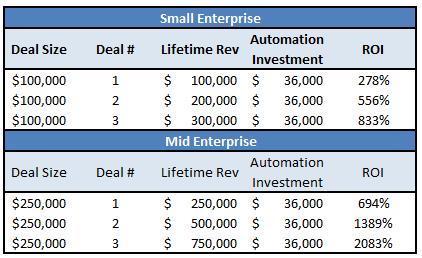
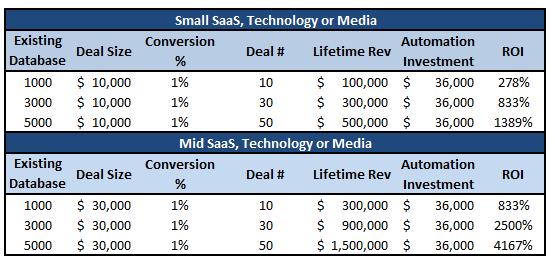
9. Create digital landing pages for your sales reps to use that are customer centric.. As your content grows create a resource page that is customer centric. Design them to help the customer make decisions. Give them educational content, evaluation content and verification content in one easy to find area. Combine your general educational content (70%) with some vertical specific content (30%) so you are speaking directly to that particular need or pain area. Don’t make the content just about you make it about them; around the needs of your customer by decision maker type. Make it easy for your customers to find what they need, and almost as important, make your brochure dynamic so you are not wasting your sales reps valuable phone time keeping up with new additions to your marketing mix. Keep them focused on selling. Gabriel Sales has developed a simple to implement landing page engine that can be up and running for you in a matter of weeks to jump start this process.
10. Re-purpose the digital land page to generate inbound traffic and remove barriers to engaging. The “sales” conversation, the digital conversation and the “social media” conversation are the same conversation. The objections your reps hear and address are the same that customers who haven’t found you yet have. Make it easy for them to find you and maximize your sales content investment by driving traffic to that page with long tail SEO and PPC campaigns that keep your costs down. Keep the language on the page focused on the customer using the language of “your” and “you” not “we” and “us”. And finally keep the requirements of your form down to the basics – customer name andemail address. Keep any other fields optional.
11. Lead Generation Reps and Demand Generation Reps have different tasks and need different skills sets. The new rules of sales engagement require your demand generation reps and your sales reps to have different skill sets. Lead gen reps are often calling cold. Their scripts are different, their call volume is different and their personality is different from what is required by reps moving inbound leads forward. Demand gen reps are there to facilitate. Lead gen reps are there to put leads in the pipe. Be conscious of the difference and either train your lead gen reps in the new rules of sales engagement (so they are not creepy or overly assertive) or hire a different rep to move deals from Marketing Qualified to Sales Qualified.
For a full overview of why we feel it makes strategic and executional sense to have your sales team involved in your sales content marketing strategy, strategic approaches to team integration and a road map for fluid communication, and demand generation strategies we invite you to read the following blogs:
Top B2B Demand Generation Requires Sales Content Marketing
Top B to B Demand Generation Requires Sales and Marketing Alignment
5 Steps to Launch or Turn Around a B to B Demand Gen Team
If you have any questions about how Gabriel Sales can help you pull together more effective demand generation strategies that are driven by your ROI statement, whether you are mid cycle or building a new effort, feel free to CONTACT US.
by Glen Springer | Feb 1, 2012
The rules of sales engagement have changed and so has b to b demand generation for three reasons:
1. Over the past 18 months a wave of technology has hit the market that allows an in house marketing team or outsourced demand generation and marketing operations team take deals deeper and further through your sales funnel than ever before. Your buyers digest, on average, 10.7 pieces of collateral prior to buying.
2. Marketing Automation Platforms allow you to nurture your customers not yet ready to buy with increased volume and increased efficiency. The ability to track the consumption of that content saves your top producers and senior talent tons of time working with your customers to transact.
3. A sales driven marketing team can create content that helps engage the customer, close business and generate leads simultaneously.
Your sales content is now an extension of your sales team. The right approach to integrating inbound efforts and your sales teams outbound efforts anchored in a smart sales content strategy can meet your customer in their buying cycle with the right team, delivering the right message at the right time. This allow you to:
- close those “ready to buy” faster and cheaper
- not lose customer “not ready to buy” or without budget and close them when they are ready
One of the tricks in making this all work is the right b to b sales content strategy. It needs to be great and it needs to be driven by your sales team and supported by marketers.
Great b to b sales content is focused on moving deals forward to close. Sales content requires that you: listen to your customers, listen to your sales reps, listen to your product specialists, create content for specific stages in the customer buying cycle and then re-purpose and repackage around a specific segments’ needs. Your sales content needs to be:
- Designed to move Marketing Qualified Leads to Sales Qualified Leads and Sales Qualified Leads to Closed Business
- Designed to be used by Inside Sales Reps and Senior Sales Reps in the Close
- Designed to be “Authentic” dialogue…no CLIOs here
- Not designed for Mass Market
- Leveraged by Inside Reps to decrease the time Executives and Product Specialists spend in educational meetings to move deals forward
- Able to train and support a sales “champion” to internally sell complex solutions or technologies within their organization.
- Once created, re-purposed across multiple platforms.
This content can also be leveraged aggressively for long tail Pay per Click campaigns and long tail Search Engine Marketing. Once proven, creative agencies can polish and take to mass market.
You need to never forget that the customer needs to remain front and center. Each piece needs to be designed for a specific stage in the customer’s buying cycle. Below is our framework for creating sales content that gets the customer and the sales team what they need to transact.
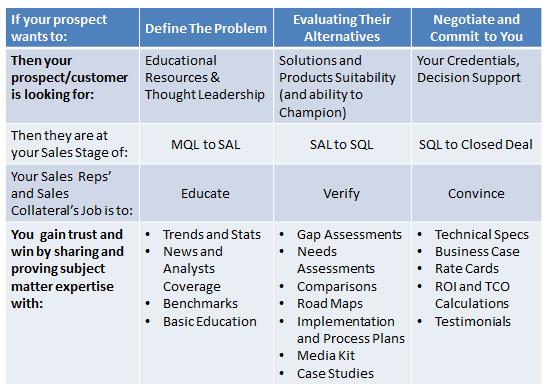
For a full overview of why we feel it makes strategic and executional sense to have your sales team involved in your sales content marketing strategy and a road map for fluid communication we invite you to read the following blogs:
Top B2B Demand Generation Requires Sales Content Marketing
Top B to B Demand Generation Requires Sales and Marketing Alignment
5 Steps to Launch or Turn Around a B to B Demand Gen Team
If you have any questions or feel like a conversation makes sense to learn how Gabriel Sales can help you pull together a more effective b to b demand generation program whether you are mid cycle or building a new effort feel free to CONTACT US.
by Glen Springer | Jan 26, 2012
“The war of sales vs marketing is both legendary and debilitating. And yet it’s probably fair to say that the future of your company lies in your ability to make the two work better together.”
Geoffrey James wrote a great and succinct piece today on “Why Sales Hates Marketing: 9 Reasons- Here’s why your marketing team and your sales team can’t get along. Hint: The sales team is probably right.”
This is probably the best summary we have ever seen on the challenges that a company faces in the in B to B marketing and we felt like it was appropriate to reduce the blog entry from a Top 10 to a Top 9. We also felt like it made sense to simply include Mr. James thoughts (although redacted in quotes below, to include his fix and then to include our best practices as a sales and marketing outsourcing company that builds b to b demand generation engines as part of sales machines.
We agree with every point Mr. James makes below and before we jump in would like to recommend you read it in its entirety. There is another link at the end of this blog.
1. Marketing Acts Superior
“Many marketers have business degrees, so they think they’re better than sales reps who don’t…” The Fix: Make certain that every marketer you hire has at least six months of experience selling something.
When building a b to b demand generation engine we think it makes sense to take it a step further. The manager running that machine should have experience selling media and advertising.
2. Marketing Doesn’t Believe in Sales
Marketers are often taught in b-school that good marketing makes a sales force unnecessary. However, unless a product is a plug-and-play commodity, your only differentiator is how you sell it. The Fix: Make it clear in the charter of the marketing team that they are there to support the sales team, not to replace it.
3. Marketing Thinks Selling Is Easy
…Many “demand creation” activities don’t create all that much demand–especially in B2B, where customers generally ignore ads, brochures, and such. The Fix: Have the marketers make sales calls–or field inside sales calls–so they can see how hard it is.
Design your b to b demand generation program anchored in what the customer is telling your sales reps. Make these feedback loops a required part of your inside sales teams comp plan.
4. Marketing Avoids Being Measured
…Marketers generally get paid when they produce leads, brochures, white papers, and so forth–even if none of that activity results in a single sale… The Fix: Compensate marketers on the ability of the current sales team to generate revenue and profit from the sales leads that marketing produces.
If your products price tag is 20K or greater and you are doing more than 20 deals per year (I know this is somewhat weak but we are talking minimums) you need to implement a marketing automation platform like Pardot. (as full disclosure we are a Denver CO Pardot Partner). This software gives you the ability to measure marketing’s digital content contribution to the sale. If you need a hard ROI calculation at other figures we can help you run those.
5. Marketing Claims to be ‘Driving Sales’
…I’ve heard this phrase dozens of time from marketers who are trying to take credit for sales, even when they had absolutely no impact on making those sales take place. The Fix: Make Marketing subservient to Sales on the organization chart.
Once again implementing a marketing automation platform will allow you to measure marketing’s contribution.
6. Marketing Pretends It’s Strategic
Brand is a reflection of product and service. If those are good, the brand is good; if not, the brand is bad. The Fix: Reward marketers for behavior that directly results in a measurable increase in revenue and profit.
Not to keep hitting on Marketing Automation but it gets rid of some of this issue. We also recommend that you have your inside sales team become involved in helping to create your digital sales content map DISCUSSED IN OUR BLOG ALIGNING SALES AND MARKETING YOUR B 2 B DEMAND GENERATION blog series.
7. Marketing Wastes Money
…Sales is perfectly capable of wasting money (big time)…there’s also no question that marketers often expend cash on fancy brochures, advertisements, and trade show junkets that have little or no business value. The Fix: Give the sales team veto power over all pricey marketing activities.
There is no reason not to market test all of your content digitally. As an outsourced sales organization most of our clients have failed before they get to us and over 50% of the time we generally find that about 70% of the material (especially designed for print) has lost its initial impact within 6 months. We are living in dynamic times which requires a dynamic approach to content.
8. Marketing Pretends It’s Engineering
While marketers often attempt to set a firm’s technical direction, most of the time, the marketers have never even spoken to a customer–and have no idea what’s technically feasible. The Fix: Let your engineers do the engineering.
B to B demand generation is not about engineering it’s about stage management. Your demand generation strategists job is to move the actors the customers wants to see on an off the stage. Stage management is about 60% science (driven by data); it’s knowing what to put the spot light on during the sales process. It’s about 30% listening (where do you get the applause and who comes back from intermission) and 10% heart (caring about getting the prospect to the proposal). Closing is about 33% product knowledge (knowing your lines inside and out), 33% business (being able to make the business case) and about 33% art (charming enough to take center stage when required).
What you want from demand generation strategist is the ability to listen to the customer, the skill to analyze the numbers and the ability to clone the closers. You need your demand generation manager to manage that stage.
9. Marketing Argues About Lead Quality
Marketing frequently provides Sales with lists of unqualified or under-qualified leads, and then accuses Sales of being clueless because it can’t close the deals…..a lead is only good if it’s possible (or even easy) for the sales team to close. Otherwise, it’s a waste of time. The Fix: Reassign (or fire) marketers who can’t provide leads that the sales team can close.
Gabriel Sales can cover all or part of your outsourced demand generation and sales and marketing outsourcing needs. We invite you to learn more about our approach that lets sales reps skilled in marketing help to bridge the gap between customer feedback and marketing and our tactics for helping our clients drive sales and marketing alignment. We do this out of self- interest as a sales outsourcing firm because when sales and marketing is aligned you have happy customers and happy customer means more closed business and everyone wins.
Thanks to Mr. James for providing the material for us to comment on at: on “Why Sales Hates Marketing: 9 Reasons- Here’s why your marketing team and your sales team can’t get along. Hint: The sales team is probably right.”
To learn more about how Gabriel Sales can help you can CONTACT US or check out more tactical tips in the B2B Demand Generation Education Resources section of our website.

by Glen Springer | Jan 24, 2012
How a B to B sales team can accelerate education, verification, and convincing of potential prospects.
In Part One we discussed the difference between “Sales” Content Marketing and Marketing. In Part Two we covered the framework we use to listen to the customer. This blog is Part Three of that three part series. It discusses how you can approach creating a successful B to B Demand Generation Outsourcing Solution in a systematic and cost effective way.
To summarize: in B2B Sales and B2B Content Marketing – the Sales Conversation, the Digital Conversation and the Social Media Conversation should and need to be the same conversation. Sales and Marketing have the same job with different methods of delivery. Below is our best practice road map for scaling that conversation. As an outsourced b to b demand generation company we recommend the following five steps in the following order:
- Have your B2B demand gen team listen to the customer and provide feedback to sales marketing team.
- Have your “sales” content marketing team create inexpensive digital content that pushes the deals forward and do some small direct marketing tests.
- Have your senior sales reps close those deals to prove concept.
- Have your demand generation team, sales operations, or marketing operations team implement a Marketing Automation Platform to score your content and give sales and marketing a shared sales quota.
- Once you have the ability to score leads and content (and digital content that works and is market tested) give it to your “Marketing” team to scale.
As discussed in Parts 1 and 2, when clients engage with Gabriel Sales in a new product launch or a demand generation campaign our two primary objectives are:
- Fill the sales pipe
- Move deals from Marketing Qualified to Sales Qualified
As a sales outsourcing company our objective is to:
- Close business
As a value add we also function as an outsourced sales marketing company and our objectives are to:
- Test assumptions about ideal target markets to find verticals that will scale
- Craft the right messages and scripts that will help move those deals through the pipe faster in that market
- Create the right digital content and establish the right marketing platforms to support moving a deal from marketing qualified to sale qualified with increased volume.
- Track the b to b digital content’s contribution to a sale by implementing a Marketing Automation Platform (for full disclosure we are a Denver CO Pardot Partner).
This type of roll out, team organization and team orientation drives tremendous accountability. Your sales team needs to document the “Sales Conversation” and provide that feedback to marketing. Your “sales” marketing team is responsible for helping sales create content that closes business. With this simple approach you are focused on filling your pipe, closing business and driving intelligence that closes more business.
Where this alignment really pays off long term is the exponential lift and efficient spends you get out of your “Marketing” Teams – both internal and your agencies. Your external teams may include Direct Marketing, Media Buyers, Publishers, and Social Media Agencies. When executed in the right order:
Your B to B demand generation team’s marketing alignment job is to map the “Sales Conversation” and provide inputs to sales marketing about what the customer wants and needs to discuss:
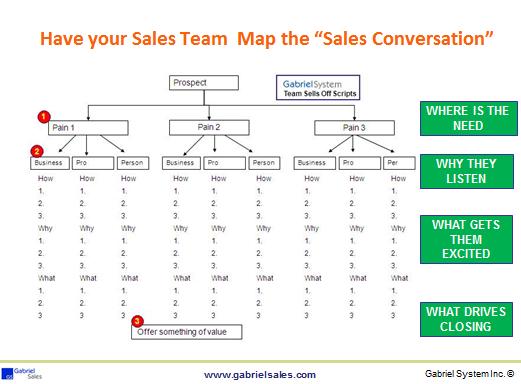
Your “sales” marketing team’s job is provide content that helps your customer get the right information at the right time in the “Digital Content Conversation”:
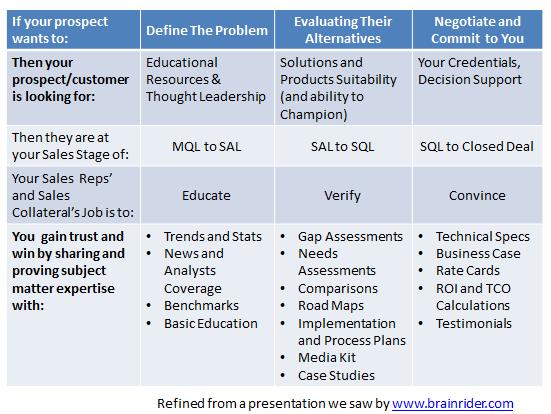 Your designated sales or marketing operations team job is to implement a platform like Pardot to Automate and Score Conversations.
Your designated sales or marketing operations team job is to implement a platform like Pardot to Automate and Score Conversations.
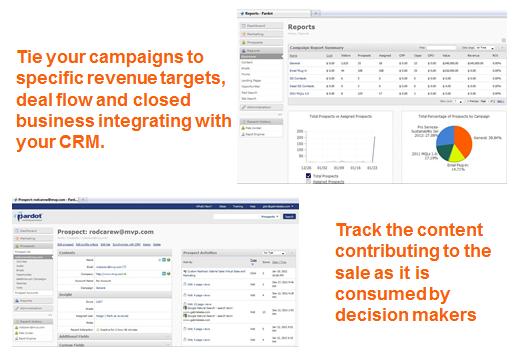
With Sales, B to B Demand Generation, Sales Marketing and Sales Operations teams aligned, your marketing teams’ job, (your creative agency, your media buyers and your publishers) is to take that “Sales Conversation” to the masses. It’s their job to turn the “Sales Conversation” and “Digital Conversation” into a “Social Media Conversation” to ramp the volume of the pipe.
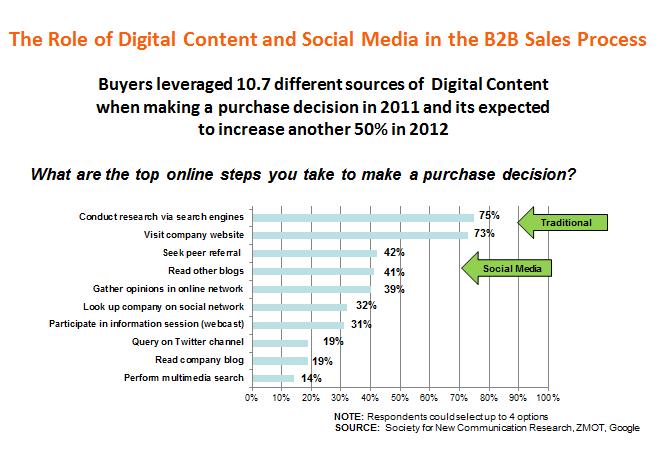 As the conversation merges across all functions this approach is just common sense. When you get it right digital strategy in place it can drive large chunks of the sales cycle. Of course the options you have still remain the same but we feel that the new rules of sales engagement dictate that your sales team becomes more active in the marketing function because it results in more deals, faster at less upfront sunk costs.
As the conversation merges across all functions this approach is just common sense. When you get it right digital strategy in place it can drive large chunks of the sales cycle. Of course the options you have still remain the same but we feel that the new rules of sales engagement dictate that your sales team becomes more active in the marketing function because it results in more deals, faster at less upfront sunk costs.
- You can pay an MR firm for an MR study or listen to your sales team as they to listen to the customer and fill the pipe at the same time.
- You can pay a creative agency to guess at what content the market wants. Or you can have an integrated sales content team and inside sales team. You can test that initial content and then pass those insights on to the creative agency to improve and polish
- You can have a publisher create a white paper for you or you can test a series of blogs that address your customers top objections and then have the publisher write that white paper (this is what major film studios do now…they test on YouTube before they green light a film project or TV pilot).
- You can have a direct marketing team drive traffic across multiple sources and platforms. Or you can get input of your sales to run AB tests so when you make that spend your opens and your conversions are stellar.
One solution we would recommend running in parallel if the budget permits is working with a social media analytics company to start mapping the social media conversation so you can map this to the sales conversation and prepare for outreach.
We hope you enjoyed this series. A year ago we were skeptical that “content is king”. That’s no longer the case. Once we experimented and attached hard metrics to digital content we were blown away by the results. We would love to share those learning with you. If you have any questions about any of our road maps or frameworks please don’t hesitate to give us a call. To see if a sales driven demand generation and sales content marketing effort may be valuable in helping you to increase your revenue and decrease your demand generation costs CONTACT US.
To read Part 1 Top B to B Demand Generation Requires Sales Content Marketing CLICK HERE.
To read Part 2 Top B to B Demand Generation Requires Sales and Marketing Alignment CLICK HERE.




 We are calling this a Top 10 demand generation strategies list, but as we went through the strategies, we felt the need to give your b to b demand gen amplifier one more notch and took it to 11. This blog post is a quick reference for your company to build a successful b to b demand generation strategies focused on improving your ROI statement.
We are calling this a Top 10 demand generation strategies list, but as we went through the strategies, we felt the need to give your b to b demand gen amplifier one more notch and took it to 11. This blog post is a quick reference for your company to build a successful b to b demand generation strategies focused on improving your ROI statement.







